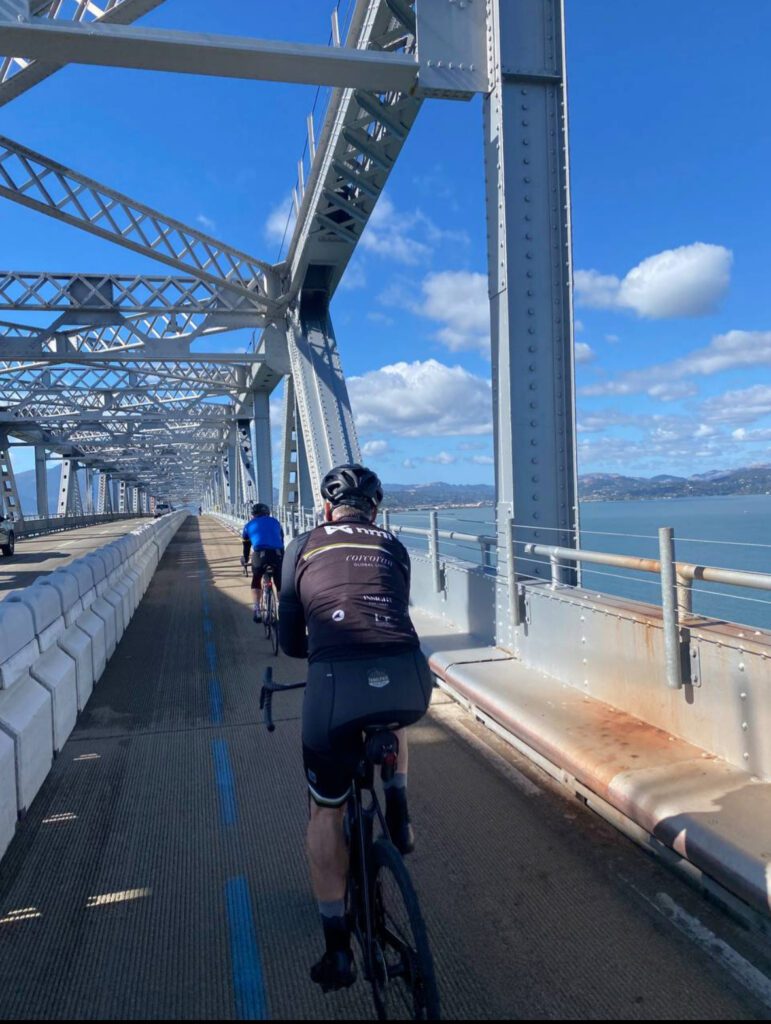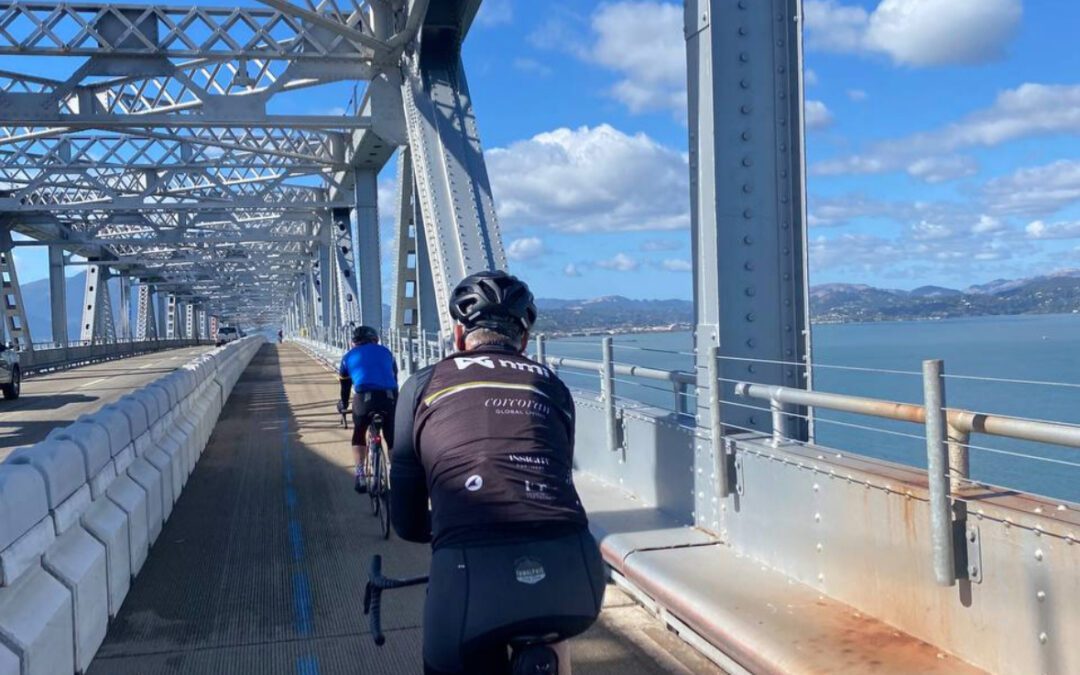 As Mill Valley residents know well, there’s no doubt that the volume of people cruising on two wheels around Mill Valley over the past several years has taken off like a rocket ship. The primary driver of that increase has been pretty clear: safety.
As Mill Valley residents know well, there’s no doubt that the volume of people cruising on two wheels around Mill Valley over the past several years has taken off like a rocket ship. The primary driver of that increase has been pretty clear: safety.
The City of Mill Valley‘s 18-month, $18 million Miller Avenue Streetscape Project in 2016 was a beast, a once-in-generation re-imagining of approximately two miles of one of Mill Valley’s two main arteries and far and away the biggest road improvement project the City had undertaken in decades.
But as is is evident from a stroll on Miller Avenue or the Mill Valley-Sausalito multi-use path just about any time of day, the popularity of bikes, e-bikes and cargo bikes has exploded in recent years, and looks to continue to surge for years to come. The forecast calls for the e-bike market to generate around 51.78 billion U.S. dollars in revenue by 2029, with a compound annual growth rate of around eight percent between 2024 and 2029, according to Statista.
If You Make It Safe, They Will Come: The amount of families and kids of all ages riding on Miller says it all. Safety has cascading effects, drawing visitors from other parts of the Bay Area and beyond without adding to car traffic, and allowing residents and visitors to more easily connect via bike to neighboring communities.
But while things continue to head in a positive direction, there have been recent setbacks. MMWD explored pilot programs for expanded bike access. That step drew a ton of excitement, but was a sensitive topic for many who have hiker safety and the environment in mind, specifically with e-bikes in mind. Nona Dennis, a representative of the Marin Conservation League, said the environmental organization is not opposed to bicycles. “The only thing that changed in an article from 1999 was that the names changed,” said board member Jed Smith “There has be no update of our recreation oversight.”
Smith said he supports the plan. “I believe it is thoughtful, balanced and incremental,” he said. “It is not a radical shift. It is led by stewardship of our critical habitat, our mission to ensure clean, safe, affordable drinking water.”
Richmond Bridge Bike Use Looks to Be Scaling Back
Marin County supervisors voted unanimously Tuesday to write a letter to the San Francisco Bay Conservation and Development Commission urging that a pilot study be initiated to evaluate the effects of such a change.
The San Francisco Bay Conservation and Development Commission, known as the BCDC, must approve the proposal. It is scheduled to take the matter up at its meeting this month or next. If the commission approves it, the plan will be implemented early next year and run for about 12 months before it’s re-evaluated. The westbound shoulder lane, which is on the upper deck of the bridge, was converted to a multiuse lane for bikes and pedestrians in 2019 as a four-year pilot project. The prior year, a part-time third traffic lane was opened on the eastbound lower deck.
“Morning congestion has not increased since the movable barrier was put into place,” Talia Smith, the county’s legislative director, told supervisors on Tuesday. “However, the incidence of traffic accidents has increased 33% since the multiuse path was put in place, and the effect has been an increased variability in morning commute times from the East Bay into Marin.”
The moveable barrier, which separates the multiuse lane from motor vehicles, prevents minor accidents or stalled cars or trucks from being immediately moved out of the path of traffic. Smith said that a number of local employers have told the county that the difficulty crossing the bridge in the mornings has affected their ability to recruit and retain employees. The proposal to open a third lane four days a week was supported by the Bay Area Council, the North Bay Leadership Council, the San Rafael Chamber of Commerce, Kaiser Permanente, MarinHealth, BioMarin, Marin Sanitary Service, the Marin County Office of Education and the Marin Association of Public Employees.
“The commuters traveling on the Richmond-San Rafael Bridge don’t have remote work options, and they don’t have transit options,” said Joanne Webster, chief executive officer of the North Bay Leadership Council. “These are commuters that typically work in the service sector. They’re construction, manufacturing, hospitality and health care workers. These sometimes unpredictable commute times can make employees late to work.”
Mark Shotwell, chief executive officer of Ritter Center in San Rafael, said, “The overwhelming majority of our staff live in the East Bay and have to travel across the Richmond-San Rafael Bridge every day. The commutes on the bridge can range from 45 minutes on a good day to 90 minutes or two hours or longer when there’s an accident on the bridge.”
Max Perrey, director of policy for Aliados Health, a network of community health centers, said Marin Community Clinics has about 160 employees — 29% of its workforce — who live in the East Bay and commute over the bridge.
“Any additional time it takes to cross the bridge during commute hours has a real impact on those employees’ lives,” Perrey said. “This in turn has a real effect on the health center’s ability to attract and retain a diverse workforce and to ensure continued access to care for patients.”
Smith, however, said the proposal was opposed by the Marin County Bicycle Coalition, Bike East Bay, Save the Bay, the San Francisco chapter of the Sierra Club and other nonprofit organizations.
Warren Wells, policy director for the Marin County Bicycle Coalition, said, “The long commutes faced by residents of the East Bay employed in Marin, among which I number, is the result of decades of exclusionary housing policy by the cities and towns in Marin and has nothing to do with the multiuse path on the bridge.”
Bruce Beyaert, chair of the Trails for Richmond Action Committee, said, “It makes no sense to shut down 5 miles of San Francisco Bay Trail linking the North Bay and the East Bay.”
Supervisor Stephanie Moulton-Peters said that means only about 70 bicyclists per day use the bridge on weekdays, since most riders make round trips. She said that by comparison, the Golden Gate Bridge averaged 3,000 bicycle trips per weekday in 2021 and 5,500 bicycle trips per day on weekends.
Moulton-Peters, the county’s representative on BCDC, acknowledged the results of the UC Berkeley study, but added, “The lived experience of people that we have heard from in this county and elsewhere is very different. We need to make a more reliable commute for the people coming from the East Bay to work in Marin.” Additional changes are planned for the bridge, including removing the toll booths at east end and reinstating a previous high occupancy vehicle lane on the westbound upper deck. Planners are also studying the possibility of using the multiuse lane as an additional lane for carpools and buses.
However, Klein said Caltrans has determined that the bridge will need structural strengthening before a third lane can be opened for full-time use by motor vehicles on a permanent basis.

